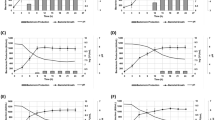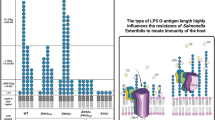Abstract
Outer membrane lipoprotein A (OmlA) is a vaccine antigen against porcine contagious pleuropneumonia (PCP), a disease severely affecting the swine industry. Here, we aimed to systematically potentiate the secretory production of OmlA in Corynebacterium glutamicum (C. glutamicum), a widely used microorganism in the food industry, by establishing a holistic development process based on our high-throughput culture platform. The expression patterns, expression element combinations, medium composition, and induction conditions were comprehensively screened or optimized in microwell plates (MWPs), followed by fermentation parameter optimization in a 4 × 1 L parallel fermentation system (CUBER4). An unprecedented yield of 1.01 g/L OmlA was ultimately achieved in a 5-L bioreactor following the scaling-up strategy of fixed oxygen mass transfer coefficient (kLa), and the produced OmlA antigen showed well-protective immunity against Actinobacillus pleuropneumoniae challenge. This result provides a rapid and reliable pipeline to achieve the hyper-production of OmlA, and possibly other recombinant vaccines, in C. glutamicum.
Key Points
• Established a holistic development process and applied it to potentiate the secretion of OmlA.
• The secretion of OmlA reached an unprecedented yield of 1.01 g/L.
• The recombinant OmlA antigen induced efficient protective immunity.
Graphical abstract







Similar content being viewed by others
Data availability
All data generated or analyzed during this study are included in this published article and its supplementary information files.
References
Alcon V, Baca-Estrada M, Vega-Lopez M, Willson P, Babiuk LA, Kumar P, Hecker R, Foldvari M (2005) Mucosal delivery of bacterial antigens and CpG oligonucleotides formulated in biphasic lipid vesicles in pigs. AAPS J 7:566–571. https://doi.org/10.1208/aapsj070357
Alcon VL, Foldvari M, Snider M, Willson P, Gomis S, Hecker R, Babiuk LA, Baca-Estrada ME (2003) Induction of protective immunity in pigs after immunisation with CpG oligodeoxynucleotides formulated in a lipid-based delivery system (Biphasix (TM)). Vaccine 21:1811–1814. https://doi.org/10.1016/S0264-410x(03)00003-3
Archambault M, Harel J, Goure J, Tremblay YD, Jacques M (2012) Antimicrobial susceptibilities and resistance genes of Canadian isolates of Actinobacillus pleuropneumoniae. Microb Drug Resist 18:198–206. https://doi.org/10.1089/mdr.2011.0150
Baltes N, Hennig-Pauka I, Gerlach GF (2002) Both transferrin binding proteins are virulence factors in Actinobacillus pleuropneumoniae serotype 7 infection. FEMS Microbiol Lett 209:283–287. https://doi.org/10.1016/S0378-1097(02)00570-0
Bandmann N, Nygren PA (2007) Combinatorial expression vector engineering for tuning of recombinant protein production in Escherichia coli. Nucleic Acids Res 35:32. https://doi.org/10.1093/nar/gkl1171
Bosse JT, Janson H, Sheehan BJ, Beddek AJ, Rycroft AN, Kroll JS, Langford PR (2002) Actinobacillus pleuropneumoniae: pathobiology and pathogenesis of infection. Microbes Infect 4:225–235. https://doi.org/10.1016/S1286-4579(01)01534-9
Brito LA, Singh M (2011) Acceptable levels of endotoxin in vaccine formulations during preclinical research. J Pharm Sci 100:34–37. https://doi.org/10.1002/jps.22267
Bunka S, Christensen C, Potter AA, Willson PJ, Gerlach GF (1995) Cloning and characterization of a protective outer membrane lipoprotein of Actinobacillus pleuropneumoniae serotype 5. Infect Immun 63:2797–2800. https://doi.org/10.1007/BF01781215
Freudl R (2017) Beyond amino acids: use of the Corynebacterium glutamicum cell factory for the secretion of heterologous proteins. J Biotechnol 258:101–109. https://doi.org/10.1016/j.jbiotec.2017.02.023
Garcia-Ochoa F, Gomez E (2009) Bioreactor scale-up and oxygen transfer rate in microbial processes: an overview. Biotechnol Adv 27:153–176. https://doi.org/10.1016/j.biotechadv.2008.10.006
Gerlach GF, Anderson C, Klashinsky S, Rossi-Campos A, Potter AA, Willson PJ (1993) Molecular characterization of a protective outer membrane lipoprotein (OmlA) from Actinobacillus pleuropneumoniae serotype 1. Infect Immun 61:565–572. https://doi.org/10.1128/IAI.61.2.565-572.1993
Haesebrouck F, Chiers K, Overbeke I, Ducatelle R (1997) Actinobacillus pleuropneumoniae infections in pigs: the role of virulence factors in pathogenesis and protection. Vet Microbiol 58:239–249. https://doi.org/10.1016/S0378-1135(97)00162-4
Hayat SMG, Farahani N, Golichenari B, Sahebkar A (2018) Recombinant protein expression in Escherichia coli (E. coli): what we need to know. Curr Pharm Des 24:718–725. https://doi.org/10.2174/1381612824666180131121940
Islam RS, Tisi D, Levy MS, Lye GJ (2007) Framework for the rapid optimization of soluble protein expression in Escherichia coli combining microscale experiments and statistical experimental design. Biotechnol Prog 23:785–793. https://doi.org/10.1021/bp070059a
Islam RS, Tisi D, Levy MS, Lye GJ (2008) Scale-up of Escherichia coli growth and recombinant protein expression conditions from microwell to laboratory and pilot scale based on matched kLa. Biotechnol Bioeng 99:1128–1139. https://doi.org/10.1002/bit.21697
Ito H, Uchida I, Sekizaki T, Ooishi E, Kawai T, Okabe T, Taneno A, Terakado N (1995) Molecular cloning of an Actinobacillus Pleuropneumoniae outer membrane lipoprotein (OmlA) from serotype 5a. Microb Pathogenesis 18:29–36. https://doi.org/10.1016/S0882-4010(05)80010-5
Kikuchi Y, Itaya H, Date M, Matsui K, Wu LF (2009) TatABC overexpression improves Corynebacterium glutamicum Tat-dependent protein secretion. Appl Environ Microbiol 75:603–607. https://doi.org/10.1128/AEM.01874-08
Lee MJ, Kim P (2018) Recombinant protein expression system in Corynebacterium glutamicum and its application. Front Microbiol 9:2523. https://doi.org/10.3389/fmicb.2018.02523
Li W, Zhou X, Lu P (2004) Bottlenecks in the expression and secretion of heterologous proteins in Bacillus subtilis. Res Microbiol 155:605–610. https://doi.org/10.1016/j.resmic.2004.05.002
Liu X, Yang Y, Zhang W, Sun Y, Peng F, Jeffrey L, Harvey L, McNeil B, Bai Z (2016) Expression of recombinant protein using Corynebacterium glutamicum: progress, challenges and applications. Crit Rev Biotechnol 36:652–664. https://doi.org/10.3109/07388551.2015.1004519
Liu X, Zhang W, Zhao Z, Dai X, Yang Y, Bai Z (2017) Protein secretion in Corynebacterium glutamicum. Crit Rev Biotechnol 37:541–551. https://doi.org/10.1080/07388551.2016.1206059
Liu X, Zhao Z, Dong G, Li Y, Peng F, Liu C, Zhang F, Linhardt RJ, Yang Y, Bai Z (2020) Identification, repair and characterization of a benzyl alcohol-inducible promoter for recombinant proteins overexpression in Corynebacterium glutamicum. Enzyme Microb Technol 141:109651. https://doi.org/10.1016/j.enzmictec.2020.109651
Liu X, Zhao Z, Zhang W, Sun Y, Yang Y, Bai Z (2017) Bicistronic expression strategy for high-level expression of recombinant proteins in Corynebacterium glutamicum. Eng Life Sci 17:1118–1125. https://doi.org/10.1002/elsc.201700087
Loera-Muro A, Angulo C (2018) New trends in innovative vaccine development against Actinobacillus pleuropneumoniae. Vet Microbiol 217:66–75. https://doi.org/10.1016/j.vetmic.2018.02.028
Long Q, Liu X, Yang Y, Li L, Harvey L, McNeil B, Bai Z (2014) The development and application of high throughput cultivation technology in bioprocess development. J Biotechnol 192:323–338. https://doi.org/10.1016/j.jbiotec.2014.03.028
Matsuda Y, Itaya H, Kitahara Y, Theresia NM, Kutukova EA, Yomantas YA, Date M, Kikuchi Y, Wachi M (2014) Double mutation of cell wall proteins CspB and PBP1a increases secretion of the antibody Fab fragment from Corynebacterium glutamicum. Microb Cell Fact 13:56. https://doi.org/10.1186/1475-2859-13-56
Meng L, Gao X, Liu X, Sun M, Yan H, Li A, Yang Y, Bai Z (2021) Enhancement of heterologous protein production in Corynebacterium glutamicum via atmospheric and room temperature plasma mutagenesis and high-throughput screening. J Biotechnol 339:22–31. https://doi.org/10.1016/j.jbiotec.2021.07.010
Moussa M, Ibrahim M, El Ghazaly M, Rohde J, Gnoth S, Anton A, Kensy F, Mueller F (2012) Expression of recombinant staphylokinase in the methylotrophic yeast Hansenula polymorpha. BMC Biotechnol 12:96. https://doi.org/10.1186/1472-6750-12-96
Mutalik VK, Guimaraes JC, Cambray G, Lam C, Christoffersen MJ, Mai QA, Tran AB, Paull M, Keasling JD, Arkin AP, Endy D (2013) Precise and reliable gene expression via standard transcription and translation initiation elements. Nat Methods 10:354–360. https://doi.org/10.1038/nmeth.2404
Peng F, Liu X, Wang X, Chen J, Liu M, Yang Y, Bai Z (2019) Triple deletion of clpC, porB, and mepA enhances production of small ubiquitin-like modifier-N-terminal pro-brain natriuretic peptide in Corynebacterium glutamicum. J Ind Microbiol Biotechnol 46:67–79. https://doi.org/10.1007/s10295-018-2091-8
Pereira AP, Mendes-Ferreira A, Oliveira JM, Estevinho LM, Mendes-Faia A (2013) High-cell-density fermentation of Saccharomyces cerevisiae for the optimisation of mead production. Food Microbiol 33:114–123. https://doi.org/10.1016/j.fm.2012.09.006
Ramjeet M, Deslandes V, Gouré J, Jacques M (2008) Actinobacillus pleuropneumoniae vaccines: from bacterins to new insights into vaccination strategies. Anim Health Res Rev 9:25–45. https://doi.org/10.1017/S1466252307001338
Rosano GL, Ceccarelli EA (2014) Recombinant protein expression in Escherichia coli: advances and challenges. Front Microbiol 5:172. https://doi.org/10.3389/fmicb.2014.00172
Rytter JV, Helmark S, Chen J, Lezyk MJ, Solem C, Jensen PR (2014) Synthetic promoter libraries for Corynebacterium glutamicum. Appl Microbiol Biotechnol 98:2617–2623. https://doi.org/10.1007/s00253-013-5481-x
Scheele S, Oertel D, Bongaerts J, Evers S, Hellmuth H, Maurer KH, Bott M, Freudl R (2013) Secretory production of an FAD cofactor-containing cytosolic enzyme (sorbitol-xylitol oxidase from Streptomyces coelicolor) using the twin-arginine translocation (Tat) pathway of Corynebacterium glutamicum. Microb Biotechnol 6:202–206. https://doi.org/10.1111/1751-7915.12005
Seo KW, Kim DH, Kim AH, Yoo HS, Lee KY, Jang YS (2011) Characterization of antigenic determinants in ApxIIA exotoxin capable of inducing protective immunity to Actinobacillus pleuropneumoniae challenge. Immunol Invest 40:465–480. https://doi.org/10.3109/08820139.2011.558151
Song Y, Matsumoto K, Yamada M, Gohda A, Brigham CJ, Sinskey AJ, Taguchi S (2012) Engineered Corynebacterium glutamicum as an endotoxin-free platform strain for lactate-based polyester production. Appl Microbiol Biotechnol 93:1917–1925. https://doi.org/10.1007/s00253-011-3718-0
Sun M, Gao AX, Li A, Liu X, Wang R, Yang Y, Li Y, Liu C, Bai Z (2021) Bicistronic design as recombinant expression enhancer: characteristics, applications, and structural optimization. Appl Microbiol Biotechnol 105:7709–7720. https://doi.org/10.1007/s00253-021-11611-5
Sun M, Gao X, Zhao Z, Li A, Bai Z (2020) Enhanced production of recombinant proteins in Corynebacterium glutamicum by construction a bicistronic gene expression system. Microb Cell Fact 19:1–12. https://doi.org/10.21203/rs.2.23801/v2
Teramoto H, Watanabe K, Suzuki N, Inui M, Yukawa H (2011) High yield secretion of heterologous proteins in Corynebacterium glutamicum using its own Tat-type signal sequence. Appl Microbiol Biotechnol 91:677–687. https://doi.org/10.1007/s00253-011-3281-8
Vandermeulen G, Marie C, Scherman D, Preat V (2011) New generation of plasmid backbones devoid of antibiotic resistance marker for gene therapy trials. Mol Ther 19:1942–1949. https://doi.org/10.1038/mt.2011.182
Wang L, Zhao S, Chen XX, Deng QP, Li CX, Feng JX (2018) Secretory overproduction of a raw starch-degrading glucoamylase in Penicillium oxalicum using strong promoter and signal peptide. Appl Microbiol Biotechnol 102:9291–9301. https://doi.org/10.1007/s00253-018-9307-8
Wang Y, Gao X, Liu X, Li Y, Sun M, Yang Y, Liu C, Bai Z (2020) Construction of a 3A system from BioBrick parts for expression of recombinant hirudin variants III in Corynebacterium glutamicum. Appl Microbiol Biotechnol 104:8257–8266. https://doi.org/10.1007/s00253-020-10835-1
Xu D, Tan Y, Shi F, Wang X (2010) An improved shuttle vector constructed for metabolic engineering research in Corynebacterium glutamicum. Plasmid 64:85–91. https://doi.org/10.1016/j.plasmid.2010.05.004
Yeh CM, Huang XH, Sue CW (2008) Functional secretion of a type 1 antifreeze protein analogue by optimization of promoter, signal peptide, prosequence, and terminator in Lactococcus lactis. J Agric Food Chem 56:8442–8450. https://doi.org/10.1021/jf801580s
Yim SS, An SJ, Kang M, Lee J, Jeong KJ (2013) Isolation of fully synthetic promoters for high-level gene expression in Corynebacterium glutamicum. Biotechnol Bioeng 110:2959–2969. https://doi.org/10.1002/bit.24954
Yim SS, Choi JW, Lee RJ, Lee YJ, Lee SH, Kim SY, Jeong KJ (2016) Development of a new platform for secretory production of recombinant proteins in Corynebacterium glutamicum. Biotechnol Bioeng 113:163–172. https://doi.org/10.1002/bit.25692
Zhang W, Yang Y, Liu X, Liu C, Bai Z (2019) Development of a secretory expression system with high compatibility between expression elements and an optimized host for endoxylanase production in Corynebacterium glutamicum. Microb Cell Fact 18:1–10. https://doi.org/10.1186/s12934-019-1116-y
Funding
This work was supported by the National Natural Science Foundation of China (No.22078128, 21878124, and 21938004), the 111 Project (No. 111–2-06), the Fundamental Research Funds for the Central Universities (No. JUSRP221032), Postgraduate Research & Practice Innovation Program of Jiangsu Province KYCX21-2028, National First-Class Discipline Program of Light Industry Technology and Engineering (LITE2018-24), the Opening Project of the Key Laboratory of Industrial Biotechnology, Ministry of Education (KLIBKF201802), British Council 527429894 and BBSRC BB/T013176/1.
Author information
Authors and Affiliations
Contributions
All experiments were performed by M.S. with assistance X.G., A.L., and P.Z. Data analysis and experimental design performed by M.S., R.W., and J.Nie. This article was drafted by M.S. and X.G. with contributions to revision by R.L-A., X.L., Z.B., and Y.Y. All the authors read and approved the final manuscript.
Corresponding author
Ethics declarations
Ethics approval
All procedures for handling the mice used in this study were reviewed and approved by the Institute of Tecon Biology Co., Ltd (SYXK2021-0006) and performed in an ethical and humane manner under veterinary supervision.
Conflict of interest
The authors declare no competing interests.
Additional information
Publisher's note
Springer Nature remains neutral with regard to jurisdictional claims in published maps and institutional affiliations.
Alex Xiong Gao Co first author.
Supplementary Information
Below is the link to the electronic supplementary material.
Rights and permissions
About this article
Cite this article
Sun, M., Gao, A.X., Ledesma-Amaro, R. et al. Hypersecretion of OmlA antigen in Corynebacterium glutamicum through high-throughput based development process. Appl Microbiol Biotechnol 106, 2953–2967 (2022). https://doi.org/10.1007/s00253-022-11918-x
Received:
Revised:
Accepted:
Published:
Issue Date:
DOI: https://doi.org/10.1007/s00253-022-11918-x




